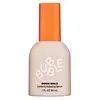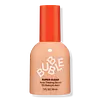What's inside
What's inside
 Key Ingredients
Key Ingredients

 Benefits
Benefits

 Concerns
Concerns

 Ingredients Side-by-side
Ingredients Side-by-side

Water
Skin ConditioningSqualane
EmollientLactic Acid
BufferingGlycerin
HumectantCaprylic/Capric Triglyceride
MaskingSodium Hydroxide
BufferingCetearyl Olivate
Sorbitan Olivate
EmulsifyingCetearyl Alcohol
EmollientGluconolactone
Skin ConditioningPolyacrylate Crosspolymer-6
Emulsion StabilisingOpuntia Ficus-Indica Fruit Extract
Skin ConditioningGlycyrrhiza Uralensis Root Extract
Skin ConditioningAnanas Sativus Fruit Juice
Skin ConditioningCurcuma Longa Root Extract
MaskingLactobacillus Ferment
Skin ConditioningLeuconostoc/Radish Root Ferment Filtrate
AntimicrobialAzelaic Acid
BufferingMalic Acid
BufferingGlycolic Acid
BufferingCucurbita Pepo Seed Extract
Skin ConditioningDehydroxanthan Gum
Emulsion StabilisingSodium Benzoate
MaskingSodium Chloride
MaskingCitric Acid
BufferingPotassium Sorbate
PreservativeWater, Squalane, Lactic Acid, Glycerin, Caprylic/Capric Triglyceride, Sodium Hydroxide, Cetearyl Olivate, Sorbitan Olivate, Cetearyl Alcohol, Gluconolactone, Polyacrylate Crosspolymer-6, Opuntia Ficus-Indica Fruit Extract, Glycyrrhiza Uralensis Root Extract, Ananas Sativus Fruit Juice, Curcuma Longa Root Extract, Lactobacillus Ferment, Leuconostoc/Radish Root Ferment Filtrate, Azelaic Acid, Malic Acid, Glycolic Acid, Cucurbita Pepo Seed Extract, Dehydroxanthan Gum, Sodium Benzoate, Sodium Chloride, Citric Acid, Potassium Sorbate
Salicylic Acid 2%
MaskingWater
Skin ConditioningGlycerin
HumectantSqualane
EmollientOctyldodecyl Stearoyl Stearate
EmollientSodium Polyacryloyldimethyl Taurate
Emulsion StabilisingSodium Polyacrylate
AbsorbentCetearyl Alcohol
EmollientCentella Asiatica Leaf Extract
Skin ConditioningColloidal Oatmeal
AbsorbentSalvia Officinalis Leaf Extract
CleansingZinc PCA
HumectantDipotassium Glycyrrhizate
HumectantMelia Azadirachta Seed Oil
EmollientSpiraea Ulmaria Flower Extract
Skin ConditioningSalix Nigra Bark Extract
Skin ProtectingXanthan Gum
EmulsifyingCoco-Glucoside
CleansingTocopheryl Acetate
AntioxidantPotassium Hydroxide
BufferingCitric Acid
BufferingPhenoxyethanol
PreservativeSalicylic Acid 2%, Water, Glycerin, Squalane, Octyldodecyl Stearoyl Stearate, Sodium Polyacryloyldimethyl Taurate, Sodium Polyacrylate, Cetearyl Alcohol, Centella Asiatica Leaf Extract, Colloidal Oatmeal, Salvia Officinalis Leaf Extract, Zinc PCA, Dipotassium Glycyrrhizate, Melia Azadirachta Seed Oil, Spiraea Ulmaria Flower Extract, Salix Nigra Bark Extract, Xanthan Gum, Coco-Glucoside, Tocopheryl Acetate, Potassium Hydroxide, Citric Acid, Phenoxyethanol
 Reviews
Reviews

Ingredients Explained
These ingredients are found in both products.
Ingredients higher up in an ingredient list are typically present in a larger amount.
Cetearyl alcohol is a mixture of two fatty alcohols: cetyl alcohol and stearyl alcohol. It is mainly used as an emulsifier. Emulsifiers help prevent the separation of oils and products. Due to its composition, it can also be used to thicken a product or help create foam.
Cetearyl alcohol is an emollient. Emollients help soothe and hydrate the skin by trapping moisture.
Studies show Cetearyl alcohol is non-toxic and non-irritating. The FDA allows products labeled "alcohol-free" to have fatty alcohols.
This ingredient is usually derived from plant oils such as palm, vegetable, or coconut oils. There is debate on whether this ingredient will cause acne.
Due to the fatty acid base, this ingredient may not be Malassezia folliculitis safe.
Learn more about Cetearyl AlcoholCitric Acid is an alpha hydroxy acid (AHA) naturally found in citrus fruits like oranges, lemons, and limes.
Like other AHAs, citric acid can exfoliate skin by breaking down the bonds that hold dead skin cells together. This helps reveal smoother and brighter skin underneath.
However, this exfoliating effect only happens at high concentrations (20%) which can be hard to find in cosmetic products.
Due to this, citric acid is usually included in small amounts as a pH adjuster. This helps keep products slightly more acidic and compatible with skin's natural pH.
In skincare formulas, citric acid can:
While it can provide some skin benefits, research shows lactic acid and glycolic acid are generally more effective and less irritating exfoliants.
Most citric acid used in skincare today is made by fermenting sugars (usually from molasses). This synthetic version is identical to the natural citrus form but easier to stabilize and use in formulations.
Read more about some other popular AHA's here:
Learn more about Citric AcidGlycerin is already naturally found in your skin. It helps moisturize and protect your skin.
A study from 2016 found glycerin to be more effective as a humectant than AHAs and hyaluronic acid.
As a humectant, it helps the skin stay hydrated by pulling moisture to your skin. The low molecular weight of glycerin allows it to pull moisture into the deeper layers of your skin.
Hydrated skin improves your skin barrier; Your skin barrier helps protect against irritants and bacteria.
Glycerin has also been found to have antimicrobial and antiviral properties. Due to these properties, glycerin is often used in wound and burn treatments.
In cosmetics, glycerin is usually derived from plants such as soybean or palm. However, it can also be sourced from animals, such as tallow or animal fat.
This ingredient is organic, colorless, odorless, and non-toxic.
Glycerin is the name for this ingredient in American English. British English uses Glycerol/Glycerine.
Learn more about GlycerinSqualane is an emollient that helps the skin hold onto moisture. It's an oily liquid that occurs naturally in certain types of fish and plant oils.
Because squalane boosts hydration in the skin, it also comes with plenty of benefits: it is an antioxidant and can help fight free radicals and skin damage. Squalane is also found to have a detoxifying effect when applied.
Squalane comes from squalene, which occurs naturally within the sebum of our skin. It is one of the oils our skin produces to keep itself hydrated. Squalane is the hydrogenated version of squalene and has a longer shelf life.
Research shows that squalane is non-irritating (even at 100% concentration).
In general, it's a fantastic ingredient. It does a great job at hydrating the skin, and it's suitable for those with sensitive skin.
The source of squalane may impact malassezia / fungal acne. This is because olive oil derived squalane can contain impurities such as fatty acids and plant waxes. Sugarcane derived squalane is recommended for anyone with malassezia concerns.
Is squalane vegan?
This depends on the source. Squalane can be derived from both plants and animals. Most squalane used in skincare comes from plants.
Please note: the source of squalane is only known if disclosed by the brand. We recommend reaching out to the brand if you have any questions about their squalane.
Read more about squalene with an "e".
Is squalane an oil?
Squalane is often called an oil, but it’s technically not; it’s a hydrocarbon, meaning it’s only made of carbon and hydrogen, unlike true oils which are triglycerides made of fatty acids and glycerol.
The term “oil-free” isn’t regulated, so companies can define it however they want. Some exclude all oils, while others just avoid mineral oil or comedogenic oils.
While some people avoid oils thinking they cause breakouts, the right kind of oil (or oil-like ingredient like squalane) can actually help balance and hydrate your skin. It’s worth testing out simple oils or squalane to see what works best for your skin.
Learn more about SqualaneWater. It's the most common cosmetic ingredient of all. You'll usually see it at the top of ingredient lists, meaning that it makes up the largest part of the product.
So why is it so popular? Water most often acts as a solvent - this means that it helps dissolve other ingredients into the formulation.
You'll also recognize water as that liquid we all need to stay alive. If you see this, drink a glass of water. Stay hydrated!
Learn more about Water